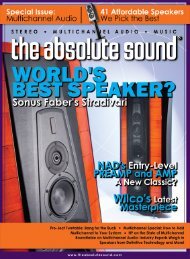You also want an ePaper? Increase the reach of your titles
YUMPU automatically turns print PDFs into web optimized ePapers that Google loves.
Equipment<br />
Report<br />
Resolution Audio<br />
Opus 21 CD Player<br />
and Integrated<br />
Amplifier<br />
A stack with high-end aspirations<br />
Alan Taffel<br />
There is no getting around it: Resolution<br />
Audio’s Opus 21 is a component stack.<br />
That’s right, a stack in the manner of<br />
those sold at big box stores by unknowing<br />
salesmen to unknowing consumers. But try<br />
not to condemn the Opus 21 through guilt<br />
by association. This particular stack might be<br />
different. And stacks, as a concept, may not be<br />
all bad.<br />
Consider, for instance, the matter of stacks as<br />
a pure packaging scheme. It turns out that they<br />
have a lot going for them. They don’t require<br />
a hand truck to lug around or a divestiture to<br />
purchase. Their stylishly coordinated aesthetics<br />
beg to be showcased in an actual living space.<br />
Operationally, stacks are beyond convenient;<br />
they are near-telepathic. And while in these<br />
respects stacks resemble all-in-one boxes, in<br />
other ways they are more like separates. Stacks<br />
are flexible and modular, and can relegate<br />
sonically combative elements—like digital and<br />
analog circuitry—to separate chassis. Perhaps<br />
most remarkably, stacks have an unheard-of<br />
effect on significant others: They implore you<br />
to buy one.<br />
Externally, the Opus 21 may be a 9.5"-wide<br />
stack; but inside it’s high end all the way. From<br />
prioritizing sonics over frivolous features, to<br />
the use of high-grade parts, to fine-tuning by<br />
ear, this is a product consistent with the best<br />
traditions of the high end.<br />
Because the Opus 21’s design and<br />
execution is in a different league than its<br />
mid-fi counterparts, so is its price. The whole<br />
works—including a CD player, mm and mc<br />
phonostages, AM/FM tuner, integrated amp,<br />
and a control center with comprehensive<br />
digital and analog connectivity—runs $7500.<br />
While clearly not in mid-fi territory, that’s still<br />
a bargain in a world where one single-function<br />
high-end component can easily reach that<br />
sum. And many Opus 21 systems will come<br />
in for less; nothing says you have to buy the<br />
full stack.<br />
All the hallmarks we<br />
audiophiles cherish<br />
are right here<br />
Stacks are like Lincoln Logs; you build them<br />
up piece by piece. In the Opus 21’s case, the<br />
analogy is particularly apt since its modules<br />
actually physically interlock by means of 25-<br />
pin connectors on their respective tops and<br />
underbellies. This approach negates the need<br />
for interconnect cables, with their inherent<br />
losses, and requires but a single solder<br />
point directly to each circuit board. Analog<br />
signals, status/command traffic, and power<br />
travel between components through these<br />
connectors and along a high-speed bus. Digital<br />
signals traverse an entirely separate path in<br />
order to quarantine their noise.<br />
Both Lincoln Log structures and stacks<br />
require a foundation. The Opus 21’s is its CD<br />
player. This module actually consists of two<br />
chassis: the transport/DAC, and the Power<br />
Center. The latter contains a power supply<br />
and large display that serve not only the CD<br />
player, but any additional modules present.<br />
Cleaving the CD player’s traditional functions<br />
makes such efficiencies possible and, again,<br />
segregates noise-generating from noisesensitive<br />
components.<br />
Because the CD player forms the Opus<br />
21’s foundation, it is the only module that<br />
can be deployed in a stand-alone capacity. But<br />
even in that role, it is far more than a simple<br />
source. The transport/DAC chassis includes<br />
a coaxial digital input that will accommodate<br />
any stereo PCM source up to 24-bit/96kHz<br />
resolution. That allows the player to host an<br />
external device such as an XM radio receiver,<br />
PC-based music server, or DVD player. The<br />
CD module also includes a built-in high-grade<br />
analog volume control. With these features,<br />
the player becomes all that many systems will<br />
need as their front end—just add a power amp<br />
and speakers.<br />
Of course, if you require an amp, the Opus<br />
21 stands ready with the S30 module. Inserting<br />
it between the CD player’s two chassis adds<br />
a sophisticated though modestly powered<br />
(30Wpc) amplifier with a transformer of its<br />
own to supplement that of the Power Center.<br />
Because the S30 is actually a full-fledged<br />
integrated amp, it incorporates a linestage, its<br />
own volume control, and three analog inputs.<br />
December 2006 The Absolute Sound 57










